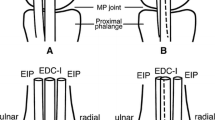Summary
The aim of this study, based upon anatomical and electrophysiological evaluation, was to identify the relationship between the morphology and physiology of the first dorsal interosseous muscle of the hand, which should be distinguished from the other dorsal interosseous muscles of the hand. Its morphology, distal attachments and physiology have been subject of numerous studies yielding conflicting results. The study reported herein was made on the basis of anatomical and electrophysiological investigation. Most of the dissections (20/34) were made on fresh specimens. Results of this study confirm the existence of the deep and superficial heads of the 1st dorsal interosseous muscle. The muscle is attached distally to the palmar plate of the metacarpophalangeal joint, the lateral tubercle of the base of the proximal phalanx of the index and the interosseous hood. Conversely, the muscle did not show any attachment to the oblique radial wing of the extensor apparatus in our dissections. The deep head of the muscle causes mainly flexion pinch between thumb and index superficial head abduction. Within the complex physiology of the various types of apposition of thumb and index, the dorsal interosseous muscle acts as a stabilizer. The results of electrophysiological study confirmed most of the interpretations deduced from morphological investigation.
Résumé
A travers une double étude anatomique et électrophysiologique nous avons recherché une relation entre la morphologie et la physiologie du muscle interosseaux dorsal du premier espace. Le muscle interosseux dorsal du 1er espace se distingue des autres interosseux dorsaux. Sa morphologie, ses insertions distales, sa physiologie ont fait l'objet de nombreux travaux qui ont mis en lumière plusieurs notions controversées. Notre travail s'appuie sur une double étude, anatomique et électrophysiologique. La majorité des dissections (20/34) ont été réalisées sur des pièces fraîches. La division du 1er interosseux dorsal en chef profond et chef superficiel reste valable. Les insertions distales intéressent la plaque palmaire de l'articulation métacarpo-phalangienne, le tubercule osseux latéral de la base de P1 de l'index et la dossière des interosseux. Nous n'avons pas trouvé d'insertion sur l'aile radiale oblique de l'appareil extenseur. La division du muscle en deux chefs se retrouve dans la fonction. Le chef superficiel entraîne surtout une flexion de l'index et le chef superficiel une abduction. Dans la physiologie complexe des différentes variétés de pinces entre le pouce et l'index, l'interosseux dorsal assure en définitive une fonction de stabilisation. L'étude électrophysiologique confirme en grande partie les interprétations tirées de l'étude morphologique.
Similar content being viewed by others
References
Bonnel F (1983) Anatomie des muscles interosseux et lombricaux de la main. Ann Chir Main 2: 172–178
Duchenne GB (1867) Physiologie des mouvements (translated by EB Kaplan, 1959). WB Saunders Co, Philadelphia and London
Eyler DL, Markee JE (1954) The anatomy and the function of the intrinsic musculature of the fingers. J Bone Joint Surg 36 A: 1–9
Kaplan EB (1965) Functional and surgical anatomy of the hand. Ed. 2 JB Lippincott, Philadelphia
Kuczynski R (1972) The variations in the insertion of the first dorsal interosseous muscle and their significance in the rheumatoid arthritis. The Hand 4: 37–39
Landsmeer JMF (1949) Les insertions des muscles interosseux de la main chez l'homme. Bull Ass Anat 3: 408–410
Long Ch, Brown ME (1964) Electromyographic kinesiology of the hand: muscles, moving the long finger. J Bone Joint Surg 46 A: 1683–1706
Long Ch (1968) Intrinsic Extrinsic muscle control of the finger. Electromyographic studies J Bone Joint Surg 50 A: 973–984
Montant R, Baumann A (1937) Recherches anatomiques sur le système tendineux extenseur des doigts de la main. Ann Anat Pathol 14: 311–319
Naouri A, Khulmann JN (1984) Agencement fasciculaire fonction et innervation du 1er interosseux dorsal de la main. Bull Assoc Anat 202: 275–282
Salsbury CR (1937) The interosseous muscles of the hand. J Anat 11: 395–403
Tubiana R, Valentin P (1963) L'extension des doigts. Rev Chir Orthop 49: 543–562
Zancolli F (1968) Structural and dynamics bases of hand surgery. JB Lippincott, Philadelphia
Author information
Authors and Affiliations
Rights and permissions
About this article
Cite this article
Masquelet, A.C., Salama, J., Outrequin, G. et al. Morphology and functional anatomy of the first dorsal interosseous muscle of the hand. Surg Radiol Anat 8, 19–28 (1986). https://doi.org/10.1007/BF02539704
Issue Date:
DOI: https://doi.org/10.1007/BF02539704




